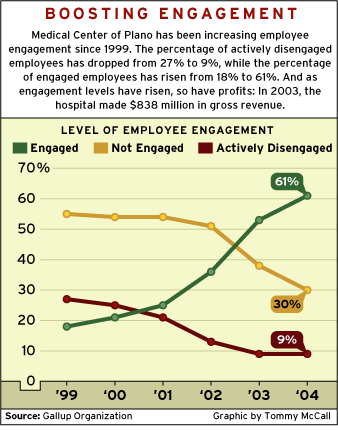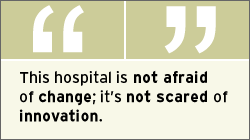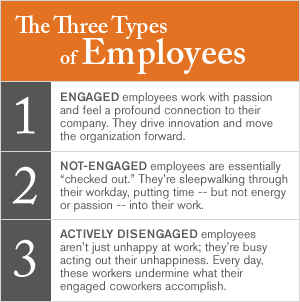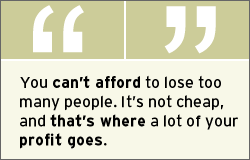Every organization has its share of rivals, but few face an onslaught of competition like the Medical Center of Plano. The 427-bed Hospital Corporation of America (HCA) facility is located in the Dallas/Fort Worth area, along with 29 other hospitals. All of them are a short drive from one another; some are nearly within walking distance of each other.
And the 250,000 residents of Plano, Texas, aren't passive healthcare recipients, either. "You've heard the old saying 'Our patient expectations are greater here than in other areas.' But it couldn't be more true than in the city of Plano," says Jerry McMorrough, vice president of human resources at the Medical Center of Plano. "It's a very affluent area." The median annual household income in Plano is about $80,000, he notes. (The national annual median household income is about $43,000.) "The people here really do have high expectations."
 |
Very few organizations deal with this kind of pressure. Those that do typically cope with competition in one of three ways: reduce prices, increase offerings, or improve quality. But hospitals aren't like other businesses. Reducing price isn't a possibility -- not when insurance companies, the government, and HMOs scrape remuneration to the bone. Increasing offerings isn't just a choice -- it's an ongoing necessity. A hospital that doesn't offer the same technology and services as every other hospital won't survive. And improving quality is a given when the organization's function is to save lives.
As McMorrough puts it, "You can't make a profit in this business unless you're a quality provider of healthcare. People aren't going to come through the door and return later if you don't provide a level of care they can't get anywhere else in the community."
So traditional methods of increasing profits aren't really available to hospitals. State-of-the-art technology and customer service, world-class public relations, and a great location are just the first steps in keeping up with the competition. For a hospital, the ultimate reality of profitable performance in business is the first reality: If you want to be profitable, you have to get the best from your employees. Because hospitals can't buy their way to engaging customers, they have to build employee engagement and capitalize on the consequent customer engagement, as well as bottom-line benefits.
So, to get to and stay at the head of the pack, a hospital must reach down and in, not up and out. At the Medical Center of Plano, reaching down and in has resulted in a 43 percentage point increase in employee engagement, a 40 percentage point decrease in first-year employee turnover, measurable cost savings, and recognition as one of the leading hospitals in HCA.
The hospital also developed a new way of thinking about human resources. "Committing to anything less than excellence," says McMorrough, "will ensure that you never attain excellence."
Diagnosis
The Medical Center of Plano was established in 1975 as a 50-bed community hospital in the middle of a cornfield. The hospital expanded to meet the local market, eventually growing to 427 beds and 1,500 employees in less than 30 years, indicating good performance and good management. And during that time, business ticked along nicely -- the hospital was in no danger of going under, it was able to attract staff, and patients trusted it. Accredited by the Joint Commission on Accreditation of Healthcare Organizations, The Medical Center of Plano was a viable business.
 |
But the local healthcare industry grew faster than the Medical Center. In the past few decades, Texas, and the Dallas/Fort Worth area in particular, have developed a stellar medical reputation -- so much so that people come from all over the world for treatment.
"Seven years ago, the Medical Center of Plano was having a difficult time completing its transition from a rural community hospital to the current 427-bed state-of-the-art tertiary care hospital," says Scott Simmons, the Â鶹´«Ã½AV partner who works with this hospital. "It had staffing problems. It had turnover problems. It had morale problems -- basically all the problems you would expect to see associated with low employee engagement."
The reasons are clear now and were actually pretty clear then: The Medical Center's recruitment efforts were neither efficient nor effective. Retention was a serious problem. The hospital was spending a lot of money due to staff turnover -- turnover rates were 25% among the staff as a whole and 70% among first-year employees, for a total loss of about 300 people that year.
McMorrough says the organization was unable to identify what was driving this turnover. "It was difficult to ascertain whether or not there was an appropriate level of job orientation because people normally didn't stick around long enough for us to find out," he says.
Purchasing new medical equipment, airing more TV commercials, or recruiting more staff wouldn't cure these ailments. The hospital needed to make changes and increase employee engagement or accept that it would lose its recognized position as the hospital of choice in Collin County to one of its 29 patient-hungry neighbors.
Prescription
The first thing the hospital had to do was decide what was vital to its future success, and then figure out how to expand on it. "We recognized that customer service was really important," McMorrough explains. "We had to reinforce the community's perception that the services we provided couldn't be exceeded by our competition." The hospital also recognized that staff recruitment and retention would be a major issue for the foreseeable future. "We look at it daily," McMorrough says.
The Medical Center turned to outside help to increase employee engagement, eventually hiring The Â鶹´«Ã½AV Organization. "It's been a marriage that fits our strategies as an organization, and it's helped us move in the direction that we want to go," McMorrough says. "A lot of Â鶹´«Ã½AV's philosophies were things that we could put our arms around because they were already part of our culture."
The first step in this process involved using the Â鶹´«Ã½AV Q12, a survey that measures 12 key employee expectations that, when satisfied, form the foundation of strong feelings of engagement. When the hospital received its initial results in 1999, management realized they had a long way to go: 18% of their employees were engaged, 55% were not engaged, and 27% were actively disengaged. Essentially, less than a fifth of the employees were driving the hospital's success, and more than a quarter were effectively undermining it. (See "Feedback for Real" in See Also and sidebar "The Three Types of Employees.")
 |
These numbers were low, and the scores ranked near the bottom for all HCA hospitals. It was enough to spur the competitive instincts of any Texan. As Simmons says, "I think they got to the point where they were sick of all the problems that were attributed to disengagement. They got serious about hiring the right people, developing those folks, and making sure that all employees are positioned correctly."
To bring up its engagement levels, the Medical Center of Plano buckled down on each Q12 item and fixed some other problems while they were at it. First, McMorrough indicates, pay and benefits programs were evaluated to ensure the hospital remained competitive in its marketplace. To help eliminate the staggering turnover in entry-level staff, the hospital also adopted Â鶹´«Ã½AV's healthcare selection tools in the spring of 2003.
As it began its evolution into a strengths-based organization, the Medical Center of Plano starting seeing results: increased employee productivity and engagement as well as reduced turnover. To continue the momentum, the Medical Center administered the Clifton StrengthsFinder -- a psychological assessment that uncovers employees' dominant talent themes and provides direction for capitalizing on them -- to its board of directors at a 2004 retreat; the board also attended a strengths consulting program. (See "Nourishing Employee Engagement" in See Also.)
In 2005, the hospital plans for all managers to go through the Clifton StrengthsFinder, and the hospital will train strengths performance coaches, who will work with employees as they discover their talents and build strengths. Eventually, the hospital plans to expand the concept until it becomes a strengths-based organization, top to bottom. "They understand the concept of talent, and they embrace the idea that employees should have opportunities to do what they do best," Simmons says.
It takes courage -- and a lot of work -- to institute changes as thorough as these. Fortunately, the Medical Center's leadership and employee culture have a healthy attitude toward change. "This hospital is not afraid of change; it's not scared of innovation," Simmons says. "They have a very driven CEO, Harvey Fishero, who likes to be out on the forefront."
Test results
In business as in medicine, a course of treatment either works or it doesn't. And in this particular situation, the results have been prompt, noticeable, and measurable. "Within 60 days after we implemented the selection tools, we started seeing turnover numbers go down, especially the numbers associated with first-year employees. These were the employees we wanted to keep because we had identified that they possessed the talents we needed," McMorrough says.
 |
Â鶹´«Ã½AV's selection instruments help employers identify applicants' talents and the right fit for the job and organization. In the spring of 2004, following the implementation of the first selection instrument, turnover among first-year employees plunged from 70% to 30%. Most first-year employees were hired for entry-level jobs -- as cooks, cleaning crew members, administrative workers -- so reduced turnover in key roles means less stress and anxiety for other employees. In the meantime, overall turnover dropped five percentage points.
McMorrough has taken a close look at the results in hard dollars; he conservatively estimates that it costs $3,000 to hire an entry-level staff member and at least $20,000 to replace an upper-level employee, such as a nurse or senior manager. McMorrough calculates that using Â鶹´«Ã½AV's selection tools saves the hospital at least $1 million a year in turnover costs. "There's always a dollar value attached," McMorrough says. "You can't afford to lose too many people. Replacing them isn't cheap, and that's where a lot of your profit goes."
At the same time, the Medical Center of Plano has achieved astonishing success in boosting engagement levels among its employees. Since 1999, the percentage of actively disengaged employees has dropped from 27% to 9%, while the percentage of employees who are not engaged has slid from 55% to 30%; the percentage of engaged employees has leaped from 18% to 61%. This tremendous success has moved the hospital from the bottom of HCA's engagement rankings to the second-highest ranking of all HCA's 191 facilities. And as engagement levels have risen, so have profits. In 2003, the Medical Center of Plano made almost a billion dollars -- $838 million in gross revenue, to be exact.
Long-term prognosis
To stay ahead of its competition, the Medical Center of Plano is currently expanding its efforts to discover, measure, and increase patient satisfaction and engagement. It is also implementing high-level executive coaching and developing the strengths of its managers and directors. It's not a quick process, but management sees it as the foundation of long-term success.
And long-term success must be the focus for any business facing stiff long-term competition. But competition is a fluid thing; any business that has enlarged its market share, increased its profitability, and outpaced its competition won't be satisfied with just winning -- it will want to win big. Medical Center of Plano is deeply reluctant to quit while it's leading the Plano pack.
"We're constantly looking at ways we can improve; we're always looking for innovative ways to get to the next level," McMorrough says. "But you never get there. If you think you are, you are already behind."